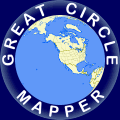Featured Map for 28 August 2023:
Southwest Airlines IOE
A friend recently landed a dream job as a pilot at Southwest Airlines. When an airline pilot starts on a new type, or upgrades from first officer (second in command) to captain (first in command), (s)he is required to complete a set of Initial Operating Experience (IOE) flights per 14 CFR §121.434. This is a twice-in-a-lifetime experience for Southwest pilots, at least since 1985 when Southwest last flew the Boeing 727.
As a woman, she joins an even more select group. Southwest had 413 female pilots at the end of 2022, 4% of their pilots, up from 3.6% in 2018. 10% of her training class was female.
Her first trip started at Southwest's home airport, Dallas Love Field, and consisted of five flights and 2,985 miles (4,803 km) over two days, ending at Nashville. All of these flights were on Boeing 737-700 aircraft, which isn't too surprising since they make up roughly half of Southwest's fleet.
The next trip started a week later and comprised eight flights and 6,064 miles (9,759 km) over three days, starting eastward from Phoenix and making a big loop around the country before finishing with flights to San José del Cabo and return. The last flight of the first day was on a Boeing 737-800, and both flights on the second day were on Boeing 737 MAX 8 aircraft. The rest of the trip was again on 737-700s.
Today's Featured Map shows her two IOE trips (red for the first five flights, blue for the remaining eight flights), spanning 13 flights and 13 airports.
(Featured Maps often go through a few revisions to come up with a map that clearly conveys the underlying data. This one started with geodesic paths but that wasn't satisfying. A variation using Bézier paths was only a little better. Yet another try with spline paths was artistic, with the red first-trip path starting to resemble the whorl of a fingerprint, but that was a little too wild even if this approach did a better job of showing what happened at Phoenix. The winning map started with a Bézier path for the first trip combined with a spline path for the second trip. Tweaks to the Bézier-path configuration and a couple of hidden points to warp the spline path so it didn't have confusing overlaps with the earlier path led to the final map. It would be nice if hacks like those hidden points weren't necessary but there's always a bit of art to creating more than the most basic maps. A big thanks to the reviewers who helped shape the best depiction of today's topic.)
References and additional information:
- Southwest Airlines
- Specialty Aircraft (727 in history)
- Southwest Women Lead on the Ground and in the Skies (13 March 2014)
- 14 CFR § 121.434 - Operating experience – Legal Information Institute (Cornell Law School)
- When Southwest Airlines broke with tradition and operated with the Boeing 727 – aeroflap
- Southwest Airlines Fleet Details and History – Planespotters.net
- Most airline pilots are men. Why aren't there more women in the industry? – The Dallas Morning News (11 April 2023)
- Major Airlines With The Most Female Pilots – statista (19 April 2018)
|
Information on this site may not be accurate or current and is not valid for flight planning or navigation. No warranty of fitness for any purpose is made or implied. Flight planning and navigation should only be done using official charts.
Copyright © 2010-2024
Karl L. Swartz.
All rights reserved.
|
